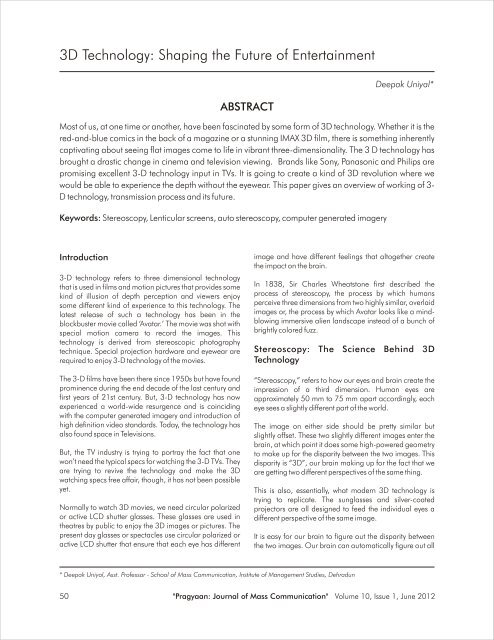Research Papers/Articles - Institute of Management Studies Dehradun
Research Papers/Articles - Institute of Management Studies Dehradun
Research Papers/Articles - Institute of Management Studies Dehradun
Create successful ePaper yourself
Turn your PDF publications into a flip-book with our unique Google optimized e-Paper software.
3D Technology: Shaping the Future <strong>of</strong> Entertainment<br />
ABSTRACT<br />
Most <strong>of</strong> us, at one time or another, have been fascinated by some form <strong>of</strong> 3D technology. Whether it is the<br />
red-and-blue comics in the back <strong>of</strong> a magazine or a stunning IMAX 3D film, there is something inherently<br />
captivating about seeing flat images come to life in vibrant three-dimensionality. The 3 D technology has<br />
brought a drastic change in cinema and television viewing. Brands like Sony, Panasonic and Philips are<br />
promising excellent 3-D technology input in TVs. It is going to create a kind <strong>of</strong> 3D revolution where we<br />
would be able to experience the depth without the eyewear. This paper gives an overview <strong>of</strong> working <strong>of</strong> 3-<br />
D technology, transmission process and its future.<br />
Keywords: Stereoscopy, Lenticular screens, auto stereoscopy, computer generated imagery<br />
Introduction<br />
3-D technology refers to three dimensional technology<br />
that is used in films and motion pictures that provides some<br />
kind <strong>of</strong> illusion <strong>of</strong> depth perception and viewers enjoy<br />
some different kind <strong>of</strong> experience to this technology. The<br />
latest release <strong>of</strong> such a technology has been in the<br />
blockbuster movie called ‘Avatar.’ The movie was shot with<br />
special motion camera to record the images. This<br />
technology is derived from stereoscopic photography<br />
technique. Special projection hardware and eyewear are<br />
required to enjoy 3-D technology <strong>of</strong> the movies.<br />
The 3-D films have been there since 1950s but have found<br />
prominence during the end decade <strong>of</strong> the last century and<br />
first years <strong>of</strong> 21st century. But, 3-D technology has now<br />
experienced a world-wide resurgence and is coinciding<br />
with the computer generated imagery and introduction <strong>of</strong><br />
high definition video standards. Today, the technology has<br />
also found space in Televisions.<br />
But, the TV industry is trying to portray the fact that one<br />
won’t need the typical specs for watching the 3-D TVs. They<br />
are trying to revive the technology and make the 3D<br />
watching specs free affair, though, it has not been possible<br />
yet.<br />
Normally to watch 3D movies, we need circular polarized<br />
or active LCD shutter glasses. These glasses are used in<br />
theatres by public to enjoy the 3D images or pictures. The<br />
present day glasses or spectacles use circular polarized or<br />
active LCD shutter that ensure that each eye has different<br />
Deepak Uniyal*<br />
image and have different feelings that altogether create<br />
the impact on the brain.<br />
In 1838, Sir Charles Wheatstone first described the<br />
process <strong>of</strong> stereoscopy, the process by which humans<br />
perceive three dimensions from two highly similar, overlaid<br />
images or, the process by which Avatar looks like a mindblowing<br />
immersive alien landscape instead <strong>of</strong> a bunch <strong>of</strong><br />
brightly colored fuzz.<br />
Stereoscopy: The Science Behind 3D<br />
Technology<br />
“Stereoscopy,” refers to how our eyes and brain create the<br />
impression <strong>of</strong> a third dimension. Human eyes are<br />
approximately 50 mm to 75 mm apart accordingly, each<br />
eye sees a slightly different part <strong>of</strong> the world.<br />
The image on either side should be pretty similar but<br />
slightly <strong>of</strong>fset. These two slightly different images enter the<br />
brain, at which point it does some high-powered geometry<br />
to make up for the disparity between the two images. This<br />
disparity is “3D”, our brain making up for the fact that we<br />
are getting two different perspectives <strong>of</strong> the same thing.<br />
This is also, essentially, what modern 3D technology is<br />
trying to replicate. The sunglasses and silver-coated<br />
projectors are all designed to feed the individual eyes a<br />
different perspective <strong>of</strong> the same image.<br />
It is easy for our brain to figure out the disparity between<br />
the two images. Our brain can automatically figure out all<br />
* Deepak Uniyal, Asst. Pr<strong>of</strong>essor - School <strong>of</strong> Mass Communication, <strong>Institute</strong> <strong>of</strong> <strong>Management</strong> <strong>Studies</strong>, <strong>Dehradun</strong><br />
50<br />
"Pragyaan: Journal <strong>of</strong> Mass Communication" Volume 10, Issue 1, June 2012


